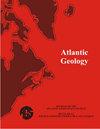加拿大东部芬迪裂谷盆地二叠系-侏罗纪陆相四足动物组合的地层、时间背景和动物多样性
IF 0.9
4区 地球科学
Q2 GEOLOGY
引用次数: 61
摘要
位于新斯科舍省和新不伦瑞克省的芬迪盆地是纽瓦克超级群中最大的暴露裂谷盆地,也延伸到芬迪湾下方。其地层可划分为4个构造层序。以二叠纪蜂窝点组和Lepreau组为代表。TS II包括Wolfville组,可能为中三叠世经济段和晚三叠世早期Evangeline段。这些成员产生了明显不同的大陆四足动物组合。TS III包括大部分的布洛米顿组,年龄从诺里亚到雷提亚。迄今为止,在布洛米顿组发现的四足动物骨骼残骸很少,但却有很多四足动物的足迹。TS - IV包括位于北山玄武岩上的Blomidon组和McCoy Brook组的晚雷地统顶部,是最晚雷地统和最早的侏罗纪(Hettangian)。McCoy Brook组产生了多种大陆四足动物,但缺乏任何典型的晚三叠世形式。最近的工作将侏罗纪(鹤唐期)基底的全球边界层型剖面和点(GSSP)与北山玄武岩之上的水平进行了对比。因此,在McCoy Brook组发现的大部分四足动物化石是最晚的雷代恐龙化石,而在较高的层位发现的蜥脚类恐龙骨骼遗骸可能是最早的河塘纪恐龙化石。芬迪盆地保存了唯一已知的、地层学严格限制的三叠纪-侏罗纪过渡时期大陆生态系统中深刻的生物变化记录。本文章由计算机程序翻译,如有差异,请以英文原文为准。
Stratigraphic and temporal context and faunal diversity of Permian-Jurassic continental tetrapod assemblages from the Fundy rift basin, eastern Canada
The Fundy basin in Nova Scotia and New Brunswick is the largest exposed rift basin of the Newark Supergroup and also extends beneath the Bay of Fundy. Its strata can be divided into four tectonostratigraphic sequences (TS). TS I is represented by the probably Permian Honeycomb Point Formation and possibly the Lepreau Formation. TS II includes the Wolfville Formation with the probably Middle Triassic Economy Member and the early Late Triassic Evangeline Member. These members have yielded markedly different assemblages of continental tetrapods. TS III comprises most of the Blomidon Formation, which is Norian to Rhaetian in age. The Blomidon Formation has yielded few skeletal remains of tetrapods to date but many tetrapod tracks. TS IV includes the late Rhaetian top of the Blomidon Formation and the McCoy Brook Formation, which overlies the North Mountain Basalt and is latest Rhaetian and earliest Jurassic (Hettangian) in age. The McCoy Brook Formation has yielded a diversity of continental tetrapods and lacks any of the characteristic Late Triassic forms. Recent work has correlated the Global Boundary Stratotype Section and Point (GSSP) for the base of the Jurassic (Hettangian) to a level well above the North Mountain Basalt. Thus most of the tetrapod fossils from the McCoy Brook Formation are latest Rhaetian in age, but the higher horizon with skeletal remains of sauropodomorph dinosaurs may be earliest Hettangian in age. The Fundy basin preserves the only known, stratigraphically tightly constrained record of the profound biotic changes in continental ecosystems across the Triassic-Jurassic transition.
求助全文
通过发布文献求助,成功后即可免费获取论文全文。
去求助
来源期刊

Atlantic Geology
GEOLOGY-
CiteScore
2.10
自引率
18.80%
发文量
0
审稿时长
>12 weeks
期刊介绍:
Atlantic Geology (originally Maritime Sediments, subsequently Maritime Sediments and Atlantic Geology) covers all aspects of the geology of the North Atlantic region. It publishes papers, notes, and discussions on original research and review papers, where appropriate to the regional geology.
 求助内容:
求助内容: 应助结果提醒方式:
应助结果提醒方式:


